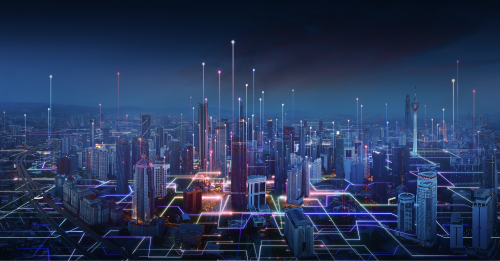Buildings nowadays use IoT to offer a better experience for people. Within these, smart lifts are the logical next piece to incorporate technology to optimise safety, monitoring and maintenance.
What is a Smart Building?
Smart buildings are sometimes referred to as ‘automated buildings’, ‘intelligent buildings’ or buildings that incorporate smart technology. A smart building is any structure that uses automated processes to automatically control the building’s operations including heating, ventilation, air conditioning, lighting, vertical transportation, and other systems. These buildings typically use sensors, actuators, and microprocessors, to collect and manage data according to a business’ functions and services.
The infrastructure in a smart building allows building owners, operators, and facility managers to improve asset reliability and performance. Goals for using this include reducing energy consumption, optimisation of space and minimising the environmental impact of buildings. Fundamentally, smart buildings help make occupants more productive and buildings more cost-effective when compared to a building that is not connected.
Smart building management
Advanced technology is changing the way buildings are managed. Smart Building Management provides deep insight into performance of building assets, maximising uptime, and solving problems before they start. Simply, Smart Building Management protects investments in buildings and ensures that they can easily be kept in optimal working order. By predicting potential issues, it drives an evolution in processes from proactive to predictive and delivers analytics to act on. For the building manager, this system provides a 360-degree view of a building assets’ real time performance.
Movement of people through buildings
The movement of people through buildings, referred to as ‘people flow’ has also changed dramatically over the years. Buildings have gone from using steps to move people between floors, to operator-driven lifts, and to the automatic push-button lifts we use today. Internet of Things (IoT) solutions, along with customer expectations, are driving a shift in the way that lifts in buildings are being designed and built for people flow.
What is a smart elevator?
Smart lifts use sensors located within the lift shaft and on the lift car which collect data and provide real time monitoring of the performance. New types of smart lifts provide significant value to the lift maintenance company and building owner who have the responsibility to maintain up-time to optimise the building and offer accessibility for occupants.
For maintenance engineers, smart elevators minimise downtime through real-time monitoring. Lifts that go down for unscheduled maintenance are an inconvenience to the building users and can often catch maintenance personnel off guard. This results in frustration and makes some areas inaccessible for those who rely on the lifts. With an effective monitoring solution, maintenance engineers can keep a close eye on the operational efficiency of the lifts. This means that maintenance engineers can not only anticipate when issues may occur, but it also means that the downtime of the lifts can be greatly reduced. For facilities managers it is one less concern to know that problems with their lifts could be detected early and dealt with swiftly.
In addition to the monitoring of lift activity, the introduction of Destination Control to manage people flow through a building has transformed the simple act of passengers travelling between floors. Instead of pushing a button to go up or down, passengers select their desired floor in the lobby area, and they are then directed to the lift that will take them to their destination with the fewest number of stops. The system can be set up to anticipate rush-hour surges in the lobby which prevents large volumes of people standing in the lobby area waiting for vertical transportation.
What possibilities does digital connectivity offer lifts?
Data can easily be gathered from lifts – this opens a plethora of options including big data, maintenance predictability, remote monitoring and maintenance, etc.
Though there are many trends and predictions in the industry outlining the benefits of gathering data on and around lifts – what information can really be gathered and how could it be used by different parties?
Why use connected devices?
Within the lift industry, the technology of things is starting to become more widespread, with larger lift manufacturers offering lift monitoring services via their lift controllers that provide an increasing amount of information. Data gathered can be used for preventative lift maintenance, which leads to higher satisfaction levels from building owners due to the increased uptime of their lifts.
What is the benefit for using this technology in lifts?
Ultimately lifts need to keep moving people through buildings and ensuring that this happens safely is paramount. Using a combination of sensors and devices to monitor lift equipment offers simpler monitoring and maintenance organisation based on data received. Gathering data such as lift doors with high levels of use, frequency and distance of travel and number of door cycles completed can help to pinpoint future issues and where maintenance may be needed. Understanding humidity, temperature, vibration and other factors can be highly beneficial for optimising lift travel, benefiting both passengers and lift maintenance providers.
What do you need to make your lift smart?
Though in the past new equipment had to be installed, it is nowadays possible to retrofit lift’s existing installations by adding new products currently already available in the market. You don’t need to replace your entire lift to enjoy the benefits of a lift monitoring system. You don’t even need to replace your lift controllers with expensive replacements.
Due to the high costs involved, most people would prefer to retrofit an existing lift, not tear it to pieces. MEMCO by AVIRE products are built with this in mind, they replace and upgrade existing components – modernising these whilst also adding the ability to monitor lifts easily.
An easy way to do this is to add a digital communication platform (DCP) as the GSM for your lift. This is the “brain” of the system and a series of other pieces of hardware can be plugged into it, upgrading the existing setup. It can read data from other MEMCO by AVIRE devices installed lift and translates these into visual information via our cloud-based platform the AVIRE HUB. It can also relay instructions to connected devices installed in the lift, including moving the lift car, re-programming devices and testing the doors. The cost to do this is a fraction of the cost* of installing a completely new system and causes minimal disruption.
This means you can add smart technology to your existing lift without needing to replace perfectly good components; the MEMCO products can augment what’s already there.
*Compared to a new controller installation or new lift.
Is it difficult to install smart devices?
If you’ve ever looked behind a lift operating panel, you know that the wiring can be complicated. However, this doesn’t mean retrofitting smart technology into a lift needs to be complicated. MEMCO solutions make upgrading a lift easy and straightforward.
Some products are designed to plug into a lift’s existing connectors, removing the need for complicated rewiring or soldering. Other devices bypass the wiring altogether, using smart technology to do the job with only a connection to the lift’s power supply.
There are even dedicated wiring looms with labelled connectors, making the life of a lift engineer easier and therefore the installation much smoother and quicker.
Straightforward lift monitoring software
Lift monitoring refers to the systematic observation and checking of the progress or quality of (the lift) over a period of time. In the world of elevators, this means being able to access the real-time status of a lift installation, at any given moment, via a Lift Monitoring System (LMS).
Being able to remotely monitor your lift in real-time helps to prevent some malfunction issues as well as trigger immediate calls to the maintenance operator to correct an issue before it escalates.
The lift monitoring service doesn’t require complicated software installed on specific machines or the interruptions caused by engineers visiting to install updates. Instead, the AVIRE HUB is based in the cloud which means your lift monitoring system is always up-to-date, and accessing it is as easy as opening an Internet browser on any device, anywhere in the world.
Smart elevators for all
Having access to a good lift monitoring service, like the AVIRE HUB offers both the lift maintenance companies as well as the building and facilities managers the access to:
- Remote, live monitoring – if any component is failing, this can be addressed immediately instead of waiting for a major breakdown which could increase repair costs as well as translate into an increased lift downtime.
- Battery status overview, and other critical information including door status, operating conditions, etc.
In other words, being able to remotely monitor your lift in real-time offers the opportunity to prevent certain issues as well as trigger immediate calls to the maintenance operator to correct an issue before it escalates further.
Reliable lift monitoring services
The potential of the LMS can be exploited as technology continues to evolve and offers new opportunities to enhance not only the passenger experience but also the management of these complex means of transportation.
Some of the predicted advances include collecting further data via the system and developing better data analysis tools that can help prevent any malfunction issues as well as continuously improve and facilitate the management of lifts.
But the golden goal is reaching the point where predictive maintenance is feasible. The aim is to enhance the LMS AI to the point where it can even predict the true lifetime of a component and trigger preventative actions. Though we are not there yet, the race towards predictive maintenance is well underway!
To find out more about how to upgrade your lifts and enjoy the benefits of smart technology, speak to one of our experts today.

